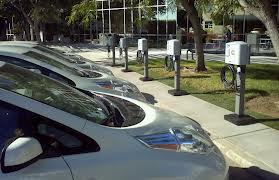For car shoppers to take plug-in electric vehicles seriously, Level 2 and fast chargers should be installed at four locations:
- Homes
- Workplaces
- Starbucks
- Trader Joes
In all seriousness, analysts say that the workplace is the leading charging location for now. According to statistics from Ecotality, workplace chargers are used three times as much as typical public chargers. A recent survey by the charger company found workplace charging grew by leaps and bounds in the first half of the year – an increase of about 61% in the first six months of 2013.
The sales figures play into the interest and use at the workplace. There were more than 8,600 plug-in hybrid/extended range and battery electric vehicles sold in the US in June 2013 versus about 3,300 in June 2012.
 As of late July, there were 7,849 public and private non-residential charging stations in the US; 1,579 were located in California, according to the US Dept. of Energy. Workplace charging plays a significant role in the non-residential charging station networks in California, where Google and other employers are taking them very seriously. Google sees them as a key perk for keeping skilled technologists on their payroll and not losing them to a nearby tech company in Silicon Valley.
As of late July, there were 7,849 public and private non-residential charging stations in the US; 1,579 were located in California, according to the US Dept. of Energy. Workplace charging plays a significant role in the non-residential charging station networks in California, where Google and other employers are taking them very seriously. Google sees them as a key perk for keeping skilled technologists on their payroll and not losing them to a nearby tech company in Silicon Valley.
In its guide for employers interested in setting up workplace charging stations, the Minnesota Pollution Control Agency presented eight steps to take for a successful workplace charging infrastructure….
1. Survey employees on their interest in a workplace-charging program.
2. Discuss findings and EV charging needs amongst employees and company’s decision-makers.
3. Examine different types of EV charging equipment options and compare the benefits and costs (Level 1, Level 2, and fast charging).
4. Determine who will own the EV charging equipment – employer, parking lot owner, or third party.
5. Look for any existing incentives that might be available for workplace EV charging.
6. Create a company policy on workplace charging.
7. Contract with a certified electrician to determine ideal locations, comply with local permitting, and install the equipment.
8. Install signage and alert employees.

